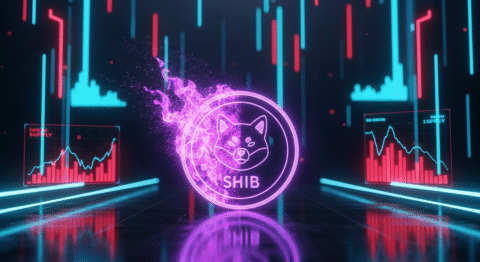Are you safeguarding your digital assets with the diligence they deserve, or are you one of the millions who might be leaving their crypto vulnerable to exploits, especially when diving into the wild world of meme coins and burgeoning altcoins? The cryptocurrency landscape, a whirlwind of innovation and opportunity, also presents inherent risks, and if you’ve participated in recent airdrops or amassed a portfolio of lesser-known tokens, understanding robust security measures is paramount. In this comprehensive guide, we’ll illuminate the critical role of Meme Wallets in protecting your hard-earned altcoin and meme asset investments, offering data-driven insights and actionable advice for every level of crypto enthusiast.
Crypto Market Overview
The cryptocurrency market in recent times has been a fascinating spectacle of both established giants and emergent challengers. Bitcoin and Ethereum continue to anchor the market, demonstrating resilience through various economic cycles. However, the real buzz often lies within the altcoin and meme coin sectors. We’ve witnessed exponential growth in specific altcoins driven by technological advancements, utility upgrades, or strong community backing. Simultaneously, meme coins, once dismissed as speculative novelties, have carved out a significant niche, often experiencing dramatic price swings fueled by social media trends and viral marketing.
The recent surge in DeFi (Decentralized Finance) protocols has also significantly impacted altcoin performance, with many tokens gaining traction due to their integration into these platforms. Airdrop campaigns, a popular method for distributing tokens and rewarding early adopters or community members, have also contributed to the rapid diversification of the altcoin market. Data from CoinMarketCap and CoinGecko consistently shows thousands of altcoins available, with a daily trading volume that, while often dwarfed by Bitcoin, represents a substantial and growing segment of the digital asset economy. The volatility remains a defining characteristic, with daily percentage changes for many altcoins and meme coins frequently exceeding 10-20%, underscoring the critical need for secure storage and vigilant asset management.

The Core Concept: How Meme Wallets Actually Works
Let’s demystify the foundational elements that make securing your digital assets, particularly your altcoins and meme coins, so vital. Essentially, when we talk about Meme Wallets, we’re referring to the tools and practices that ensure the privacy, integrity, and accessibility of your cryptocurrency holdings, especially those tokens that might be more susceptible to niche vulnerabilities or rapid value fluctuations.
What Are Altcoins / Meme Coins / Airdrops?
Altcoins: Short for “alternative coins,” altcoins are any cryptocurrencies that are not Bitcoin. They emerged as projects aiming to improve upon Bitcoin’s perceived limitations, introduce new features, or cater to specific use cases. Examples range from Ethereum, which introduced smart contract functionality, to specialized coins for privacy (Monero), decentralized applications (Cardano), or faster transactions (Solana). They operate on their own blockchains or are forks of existing ones, each with its unique protocol and set of features.
Meme Coins: These are cryptocurrencies that originated from internet memes, jokes, or social media trends. While often lacking a strong underlying technological innovation or clear utility at inception, they have gained massive popularity and market capitalization due to strong community engagement, viral marketing, and celebrity endorsements. Dogecoin and Shiba Inu areprime examples, demonstrating how cultural phenomena can translate into significant economic value (and volatility) in the crypto space. Their value is heavily influenced by community sentiment and social media buzz rather than traditional market fundamentals.
Airdrops: An airdrop is a promotional strategy used by cryptocurrency projects to distribute free tokens to a wide audience. This is often done to spread awareness, build a community around a new project, or reward existing token holders on a particular blockchain. Users typically receive these tokens by performing certain tasks, such as holding another cryptocurrency, signing up for a newsletter, or following a project on social media. While a great way to acquire new assets, managing received airdrops securely is crucial.
Key Components & Technologies
The security and functionality of your altcoins and meme coins are underpinned by several key technologies and principles:
Blockchain Technology: At its heart, every cryptocurrency, including altcoins and meme coins, relies on blockchain technology. This is a distributed, immutable ledger that records all transactions across a network of computers. This decentralization makes it incredibly difficult to tamper with transaction history, ensuring transparency and security.
Private Keys and Public Keys: When you own cryptocurrency, you possess a private key. This is a secret alphanumeric string that grants you access to and control over your digital assets on the blockchain. It’s like the password to your bank account, but infinitely more important. Your public key is derived from your private key and is used to generate your wallet address – the address you share with others to receive funds. The fundamental principle of crypto security is the absolute safeguarding of your private key.
Cryptographic Hashing: This process ensures the integrity of data on the blockchain. Transactions are grouped into blocks, and each block contains a unique cryptographic hash of the previous block, creating a chain and making it virtually impossible to alter historical data without detection.
Wallet Software: This is the crucial interface that allows you to interact with the blockchain and manage your private and public keys. Wallets don’t “store” your crypto; rather, they store your keys that prove ownership and allow you to send and receive. Understanding the different types of wallets is key to choosing the best Meme Wallets solution for your needs:
- Hot Wallets: Connected to the internet (e.g., mobile wallets, desktop wallets, exchange wallets). These are convenient for frequent transactions but carry a higher risk of online threats.
- Cold Wallets: Offline, meaning they are not connected to the internet (e.g., hardware wallets, paper wallets). They offer the highest level of security for long-term storage but are less convenient for active trading.
The Data-Driven Perspective
To truly appreciate the need for robust security measures like those offered by effective Meme Wallets, it’s important to look at the market through a data lens.
Market Data & Trends
The altcoin market capitalization has seen significant growth over the past few years. While speculative surges do occur, often driven by hype, the underlying trend points towards increasing adoption and diversification of the crypto ecosystem beyond Bitcoin. For example, data aggregators show that the total market cap of altcoins (excluding Bitcoin) has grown from tens of billions of dollars a few years ago to hundreds of billions, and at times, over a trillion dollars.
Meme coins, though often volatile, have also demonstrated remarkable market presence. Projects like Dogecoin and Shiba Inu have achieved market capitalizations in the billions, attracting millions of users and investors. This rapid rise underscores the power of community and viral marketing but also highlights the speculative nature and the potential for extreme price swings. Airdrop statistics also reveal the sheer volume of new tokens being distributed. Millions of tokens are generated and distributed annually, often finding their way into the wallets of crypto enthusiasts. This influx of assets, some valuable and some not, necessitates careful management and protection.
Tokenomics & Market Health
Tokenomics refers to the economic design and incentive structure of a cryptocurrency. For altcoins and meme coins, understanding their tokenomics is vital for assessing their potential value and risk:
- Supply: Is the token supply fixed (like Bitcoin), inflationary, or deflationary? High inflation rates can dilute value, while deflationary mechanisms (like token burns) can potentially increase scarcity.
- Distribution: How were the tokens initially distributed? Fair launches, ICOs (Initial Coin Exchange Offerings), IEOs (Initial Exchange Offerings), and airdrops all have different implications for decentralization and potential for market manipulation.
- Utility: Does the token have a real-world use case? Does it power a platform, facilitate transactions, grant governance rights, or offer staking rewards? Tokens with strong utility are generally considered more sustainable than those driven purely by speculation.
- Vesting Schedules: For tokens launched by teams or venture capitalists, vesting schedules dictate when these parties can sell their holdings. This helps prevent sudden, large sell-offs that could crash the price.
For meme coins, tokenomics often play a secondary role to community sentiment and marketing. However, understanding the total supply, circulating supply, and any token burn mechanisms can still offer insights into potential price movements and speculative sustainability. The sheer volume of meme coins with massive circulating supplies and little to no intrinsic utility highlights the need for caution and the importance of securing these assets in Meme Wallets that prioritize safety over ease of access for frequent, speculative trades.
Risks, Challenges & Competition
The allure of altcoins and meme coins is undeniable, but it’s crucial to acknowledge the significant risks and challenges involved.
Risks of Altcoins and Meme Coins
- Extreme Volatility: This is perhaps the most significant risk. Meme coins, in particular, can experience price pumps and dumps in a matter of hours or days, driven by social media trends or whale activity. Altcoins, while often more tied to project development, can also be highly volatile due to market sentiment, regulatory news, or technological breakthroughs (or failures).
- Security Vulnerabilities:
- Smart Contract Exploits: Many altcoins and DeFi tokens operate on smart contracts. Flaws in these contracts can be exploited by hackers, leading to the loss of millions in user funds.
- Rug Pulls: This is a common scam in the meme coin space where developers abandon a project after attracting significant investment, taking the funds with them. This often leaves token holders with worthless assets.
- Phishing and Scams: Given the often-experimental nature of these tokens, users are frequently targeted by phishing attempts, fake airdrops, and malicious websites designed to steal private keys or seed phrases.
- Regulatory Uncertainty: Governments worldwide are still developing regulations for cryptocurrencies. Changes in regulations can significantly impact the value and legality of certain altcoins or the platforms they operate on.
- Lack of Utility and Fundamentals: Many meme coins and even some altcoins lack a robust use case beyond speculation. Their value is entirely dependent on continued community interest and buying pressure, making them inherently unstable.
- Information Asymmetry: Beginners might not have access to or understand the technical details or underlying market forces affecting certain altcoins, making them vulnerable to making poor investment decisions based on hype.
How Do Meme Wallets Stack Up Against Competitors?
When we talk about security for your altcoin and meme assets, we’re essentially comparing different types of crypto wallets. The “competitors” to robust, security-focused Meme Wallets (often leaning towards hardware or advanced software wallets) are typically:
| Feature | Simple Hot Wallets (e.g., Exchange Wallets) | Advanced Software Wallets (e.g., Dedicated Mobile/Desktop) | Hardware Wallets (e.g., Ledger, Trezor) |
|---|---|---|---|
| Security Level | Low to Medium – Vulnerable to online hacks, exchange failures. | Medium to High – User controls keys, but vulnerable to device malware. | Very High – Private keys stored offline, immune to online threats. |
| Ease of Use | Very High – User-friendly interface, integrated trading. | High – Generally intuitive, good for frequent use. | Medium – Requires initial setup, slightly more complex for transactions. |
| Altcoin/Meme Coin Support | Varies by exchange; often limited support for less common tokens. | Broad support, depending on wallet development. | Excellent support for a wide range of coins, including many meme coins and altcoins through companion apps/integrations. |
| Transaction Speed | Fast (within the exchange network). | Fast (dependent on blockchain network). | Fast (after signing transaction on device). |
| Cost | Free (with potential trading fees). | Free or Paid. | Paid (one-time purchase). |
| Best For | Active traders, small amounts, beginners. | Frequent users, intermediate holders. | Long-term holders, high-value assets, maximum security. |
| Vulnerability | Exchange hacks, phishing, compromised accounts. | Device malware, sophisticated phishing, seed phrase compromise. | Physical loss/damage, compromised device initialization, advanced supply chain attacks (rare). |
For individuals holding a significant amount of altcoins or valuable meme coins, moving away from basic exchange wallets towards more secure, self-custody Meme Wallets like hardware wallets or robust, well-vetted software wallets is a critical step. These solutions ensure that your private keys, the ultimate gatekeepers to your assets, remain under your sole control, significantly mitigating the risk of theft or unauthorized access.
The Future Outlook
The trajectory of altcoins and meme coins suggests a market that will continue to evolve, driven by technological innovation, evolving investor sentiment, and increasing mainstream adoption.
What’s Next for Altcoins / Meme Coins / Airdrops?
- Increased Utility and Adoption: As the blockchain space matures, many altcoins are focusing on developing real-world utility. This includes applications in DeFi, supply chain management, gaming, NFTs (Non-Fungible Tokens), and decentralized autonomous organizations (DAOs). Projects with tangible use cases and strong development teams are likely to see sustained growth.
- Regulation and Compliance: We can expect to see increased regulatory clarity in the coming years. While this might bring challenges for some projects, it could also lend legitimacy to the crypto market as a whole, attracting institutional investment and broader public trust.
- Meme Coin Evolution: While the hype cycles for meme coins will likely continue, there’s a growing trend of meme coins attempting to develop underlying utility or integrate with broader ecosystems, blurring the lines between pure meme coins and more utility-driven tokens. Community-driven governance and deflationary mechanisms might become more sophisticated.
- The Rise of Specialized Wallets: The demand for enhanced security and tailored features for specific types of assets will likely drive the development of more specialized wallets. This is where the concept of “Meme Wallets” as a category of highly secure, user-friendly solutions for navigating the volatile meme coin and altcoin markets becomes even more pertinent. We might see wallets with integrated scam detectors, custom alert systems for price volatility, and simplified staking or farming interfaces for new altcoins.
- Airdrop Sophistication: Airdrops will likely continue as a marketing tool, but we may see shifts towards more targeted or utility-based airdrops, rewarding users for specific interactions within a project’s ecosystem rather than generic social media engagement.
For holders of altcoins and meme coins, the key takeaway is that security must evolve alongside the market. Understanding the risks and leveraging the best available tools for asset protection, effectively managing your Meme Wallets, is not just a recommendation – it’s a necessity.
Conclusion
The cryptocurrency market, especially the vibrant and often unpredictable realms of altcoins and meme coins, offers immense potential but demands a vigilant approach to security. From understanding the fundamental technologies like blockchain and private keys to recognizing the nuances of tokenomics and the ever-present risks of volatility and scams, every step of your crypto journey requires informed decision-making.
We’ve explored how robust Meme Wallets, particularly those offering self-custody like hardware or secure software solutions, are indispensable for safeguarding your digital assets. Choosing the right wallet means prioritizing the security of your private keys, ensuring that your investments remain under your ultimate control, shielded from the myriad online threats.
What are your thoughts on altcoin investments? Have you experienced a memorable airdrop? Share your insights, your preferred wallet solutions, or any burning questions you have in the comments below! For those looking to deepen their understanding of crypto security and investment strategies, be sure to explore our other articles on [link to related article 1] and [link to related article 2]. And don’t forget to subscribe to our newsletter for the latest crypto news, market analyses, and security tips delivered straight to your inbox!
FAQs
What is the safest type of wallet for meme coins?
Hardware wallets are generally considered the safest for storing meme coins and altcoins, as they keep your private keys offline, making them immune to online hacking attempts.Can I use a single wallet for all my altcoins and meme coins?
Yes, most popular software and hardware wallets support a wide range of altcoins and meme coins. However, always check the wallet’s compatibility list before transferring your assets.What is a “seed phrase” and why is it so important?
A seed phrase (or recovery phrase) is a list of words that acts as a master key to your wallet. It’s used to back up and restore your wallet if you lose access to your device or application. It is critically important to keep your seed phrase secret and offline, as anyone who has access to it can access and steal your funds.How can I protect myself from meme coin scams?
Be wary of “get rich quick” schemes, unsolicited airdrop links, and projects with unclear whitepapers or anonymous developer teams. Stick to well-researched projects and utilize secure Meme Wallets to store your assets, keeping only small amounts on exchanges for trading. Always double-check wallet addresses and contract addresses before sending funds.Are exchange wallets secure for meme coins?
Exchange wallets are convenient for trading, but they are custodial, meaning the exchange holds your private keys. This makes them more vulnerable to exchange hacks or regulatory actions. For long-term storage or significant amounts of meme coins and altcoins, it is highly recommended to move them to a non-custodial wallet (like a hardware or secure software wallet) where you control your private keys.What are the best meme coin wallets?
When looking for the Best meme coin wallets, consider options like Ledger Nano S/X and Trezor Model T for hardware security, and Trust Wallet or Exodus for user-friendly mobile/desktop software wallets that offer broad altcoin support. Always ensure the wallet actively supports the specific coins you intend to hold.






